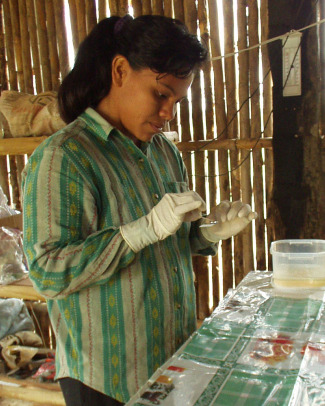Intestinal infections and lower height in Amazonian people

Infections produced by intestinal parasites are very extended among South American indigenous people. That kind of diseases have been forgotten in western civilization. The present work, which included interviews to the aborigens, withdrawal of statistical information on the height, weight, corporal fat ... and the capture of fecal samples, has concluded that children infected by anchylostoma are smaller and have evident signs of delay in their growth.
Infectious diseases, such as diarrheal disease and parasitic infections, are an important source of nutritional stress throughout the rural tropics. Continual exposure to such infections negatively impact childhood growth, development, and lifelong patterns of health. Although they are among the oldest infections of humans, gastrointestinal worms, or soil-transmitted helminths, are currently concentrated in the poorest, most vulnerable populations. Classified as "neglected diseases", research on helminth infections has recently reestablished their significance as a global health problem. In this study, we considered the importance of intestinal parasites for childhood health and nutritional status in an indigenous group in lowland Bolivia.
During 2003 and 2004, lifestyle and health interviews were conducted among 43 households in Tsimané indigenous communities, Beni Department. Parents were asked to discuss illness in their children and body composition information including height, weight, and measures of body fatness were collected for 92 children between the ages of 2 and 10.9 years. Finally, samples to perform parasite analyses were obtained for microbiological analysis. The most common helminth observed was hookworm, with 76% of children infected. In addition, 15% of children had polyparasitic infections, or were infected with more than one species of gastrointestinal parasite. Although parents recognize that worm infections are common in their children, illnesses such as diarrhea, respiratory infection, and fevers are perceived to be more pressing health threats.
Indigenous South American groups are characteristically short as adults. It remains unclear if this growth stunting reflects genetic patterns or poor growth during childhood due to exposure to infection. Previous research in the area has shown that children begin to suffer growth stunting at about 1-2 years of age, a time in which children are weaned, begin to walk, and experience frequent infections. In this study, we found that children who were positive for hookworm were shorter and lighter for their age than their uninfected peers. A possible explanation of these results is that social and cultural practices are effective at reducing the occurrence of symptoms and overt disease associated with infection. It is also possible that growth stunting represents a developmental accommodation to the synergistic effects of nutrition and disease stressors throughout childhood. The results of this work on helminth infections demonstrate the multifaceted causes of poor health among indigenous South American populations.
References
"Influence of Helminth Infections on Childhood Nutritional Status in Lowland Bolivia". Tanner, S; Leonard, WR; McDade, TW; Reyes-Garcia, V; Godoy, R; Huanca, T. AMERICAN JOURNAL OF HUMAN BIOLOGY, 21 (5): 651-656 SEP-OCT 2009.


